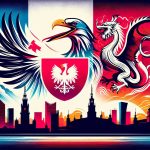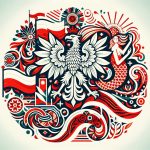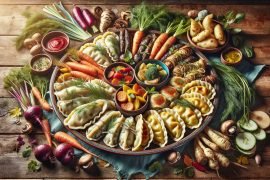
Polish culture is full of interesting traditions and symbols that tell the story of a country that has faced many challenges with strength and elegance. There are many parts of this culture, from the stories and national holidays that are important to the Polish people, to the special foods they eat and the folk art they create. Each part of the culture has its own story to tell.
The Polish language also plays a big role in keeping the country’s identity and spirit alive. As we look closer, it’s interesting to think about how these cultural parts have influenced the way Polish people see the world and their place in it today.
The Significance of Folklore
Polish folklore is more than just old stories and legends; it’s a vital part of Poland’s cultural heritage. It includes myths, folk tales, dances, songs, and rituals that tell us a lot about Poland’s history, values, and community spirit. These elements of folklore are like a window into the cultural soul of Poland, showing us how past generations thought, felt, and lived.
For example, Polish folk tales often feature themes of bravery and resilience, reflecting the nation’s history of overcoming adversity. The traditional dance, Polonaise, embodies the spirit of community and unity, which is central to Polish identity. Folk songs, with their rich references to nature, highlight the Polish people’s deep connection to their natural surroundings.
By exploring these aspects of Polish folklore, we gain insight into the collective wisdom and moral values passed down through generations. This folklore is not just about preserving the past; it plays an active role in shaping the present and future by fostering a sense of belonging and pride among the Polish people.
In a more practical sense, this rich cultural heritage has inspired a range of products and experiences that celebrate Polish traditions. From folk music albums to cultural festivals and even modern interpretations of traditional Polish crafts, there are many ways for both Poles and people around the world to engage with and appreciate this vital aspect of Poland’s culture.
In conversation, discussing Polish folklore can be a way to connect with others through shared stories and experiences. Whether it’s marveling at the intricate steps of a folk dance or recounting a beloved legend, these pieces of folklore are not just relics of the past but living traditions that continue to enrich the cultural landscape of Poland.
National Holidays and Celebrations
Polish culture shines brightly through its national holidays and celebrations, which bring people together to honor their country’s history and achievements. One of the key holidays is Constitution Day, celebrated on May 3rd. This day commemorates Poland’s 1791 Constitution, a landmark document in European history that symbolizes the nation’s pursuit of freedom and independence. It’s not just about remembering a historic event; it’s a day when Poles express their national pride and reflect on their country’s journey towards sovereignty.
Another significant holiday is Independence Day on November 11th. This day marks a pivotal moment in Poland’s history – the regaining of independence in 1918 after being partitioned for 123 years. It’s a powerful reminder of Poland’s resilience and the unyielding spirit of its people. Independence Day is celebrated with ceremonies and parades, where the red and white of the Polish flag colors towns and cities, showcasing the unity and strength of the nation.
These holidays do more than provide a break from the daily routine. They are essential parts of Polish culture, embedding the nation’s history and identity into the collective consciousness of its people. Through these celebrations, Poles reconnect with their past, reinforcing a sense of national solidarity. The observance of these days involves not just passive participation but active engagement in remembering, celebrating, and educating about the significance of these moments in Poland’s history.
Polish Culinary Traditions
Polish cuisine is a fascinating blend of tastes and traditions that mirrors the country’s rich past and geographical setting. At its core, Polish food is based on ingredients like grains, dairy, and a wide range of meats, with pork standing out as a favorite. The seasons greatly influence what people eat, guiding the use of ingredients and shaping the menu. For example, to overcome the challenge of cold winters, Poles have mastered preservation methods such as pickling and fermenting vegetables to keep them available year-round.
The variety found in Polish dishes comes from a mix of local traditions and foreign influences. Over the years, Poland has absorbed culinary styles from its neighbors and beyond, including German, Hungarian, Jewish, and Italian kitchens. This mix has created a unique Polish flavor that tells a story of cultural exchange and adaptation.
For example, consider the popular dish pierogi, which are dumplings that can be filled with a range of ingredients, from potatoes and cheese to fruits. Pierogi showcase the Polish knack for combining simple, locally sourced ingredients into a dish that’s both versatile and delicious. Another classic is bigos, often referred to as ‘Hunter’s Stew,’ a hearty mix of sauerkraut, meat, and various seasonings, cooked over several days. It’s a perfect example of how Poles make the most of their resources, adjusting the recipe to what’s available or in season.
Polish cuisine doesn’t just offer insight into the country’s culinary practices; it opens a window into Poland’s history and the resilience of its people. Through food, we see how Poles have navigated the challenges of their environment and history, blending tradition with innovation to create a rich culinary heritage that continues to evolve.
Whether you’re sampling a plate of pierogi, enjoying a bowl of bigos, or savoring the tang of a fermented cucumber, you’re experiencing a piece of Poland’s history and cultural mosaic. Polish cuisine, with its depth of flavors and textures, invites everyone to explore its stories and traditions, making it a compelling aspect of the country’s cultural identity.
Folk Art and Handicrafts
Polish folk art and handicrafts showcase the unique culture and history of Poland, reflecting the diverse influences and traditions that shape this vibrant nation. For example, in the Lowicz region, artisans create beautiful paper cuttings. These aren’t just simple decorations; they’re intricate works of art that capture the essence of nature and the changing seasons through their vivid patterns and colors.
Another remarkable aspect of Polish craftsmanship is woodcarving, particularly notable in the Podhale region. Here, skilled craftsmen draw inspiration from local folklore to carve detailed figures and scenes that tell stories of the region’s history and mythology. This isn’t just about preserving old techniques; it’s about continuing a living tradition that evolves with each generation.
Polish pottery, especially from Bolesławiec, stands out for its functionality and beauty. The distinctive blue and white patterns, hand-painted with precision, make each piece a work of art. But these ceramics aren’t just for show; they’re durable and practical, perfect for daily use or special occasions.
These crafts go beyond being simple souvenirs; they’re expressions of a culture that deeply values its history and the skill of its artisans. They represent a dialogue between the past and present, showing how traditional techniques can find new life in contemporary settings. For those interested in experiencing this rich cultural heritage, visiting local markets or workshops in Poland offers a chance to see these artisans at work and perhaps bring home a piece of Polish tradition.
In discussing Polish folk art and handicrafts, it’s clear that they are more than just remnants of history. They are living expressions of a nation’s identity and creativity, bridging the gap between tradition and modernity. Whether it’s through the vibrant paper cuttings of Lowicz, the intricate woodcarvings of Podhale, or the iconic pottery of Bolesławiec, Poland’s rich tapestry of crafts continues to enchant and inspire.
The Polish Language as a Symbol
The Polish language is more than just a way to communicate; it’s a key part of Poland’s cultural identity and its people’s ability to persevere through tough times. Unlike many other languages, Polish has specific sounds and a structure that set it apart. For example, it’s known for having several consonants grouped together, which is unusual and highlights its unique Slavic roots. This uniqueness is not just about language; it’s a reflection of Poland’s rich history and traditions.
Throughout history, especially when Poland was under foreign control, the Polish language played a critical role. It was like a secret code that kept the Polish people connected and helped them resist efforts to make them adopt foreign ways of life. This resistance is a testament to the language’s importance in the fight for independence and maintaining a national identity.
Let’s also talk about the contributions of the Polish language to literature and poetry. Writers and poets who create in Polish have added valuable works to the global library, demonstrating the language’s flexibility and richness. These works are not just important for their artistic value; they also share Polish perspectives and experiences with the world.
In essence, the Polish language does a lot more than just allow Poles to talk to each other. It’s a source of national pride and a key part of Poland’s cultural heritage. It stands as a reminder of the country’s history, its struggles for freedom, and its contributions to global culture. Through the preservation and celebration of the Polish language, Poland not only honors its past but also ensures that its unique identity continues to thrive in the global community.
Conclusion
Polish culture is rich because of its unique traditions and symbols. These include everything from folklore and national holidays to the food people eat, the traditional art they create, and the language they speak.
All these elements help keep Poland’s history and social values alive, giving Polish people a strong sense of who they are. When you look closer at these cultural aspects, you really see how they mix history, what’s important to society, and the connections between people.
This mix helps to keep Polish heritage important, showing how it’s a key part of Poland’s identity and efforts to keep its culture alive.






Comments are closed.